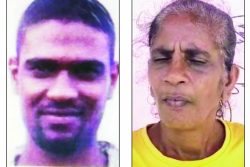Dear Editor,
Black members of the PPP have, from time immemorial always faced the brunt of attacks from the PNC; BH Benn, EMG Wilson, Una Mulzac, George David, Isaac Fraser, Arthur Cumberbatch, Charlie Cassato, Harold Snagg, Louis Mitchell aka ‘Coffee’, Eric Gilbert, Cyril Belgrave, Shirley Edwards, Victor James, Gladwin Levius, Maurice Herbert, Clinton Collymore, Gerald Beaton and Roger Luncheon were some of the untold number of Black PPP stalwarts who suffered in one way or another under the Burnham dictatorship. Luncheon’s emergence in the 1980’s should be viewed as a continuation of the struggle waged by many outstanding Black party activists and leaders who preceded him. As heroes go, recall a line from a section of Pericles’ speech, ‘the whole earth is the tomb of famous men’. I recall four specific instances in the pre-1992 and late 1997 periods when his political profile catapulted him onto the political arena as a key player. In this regard, context is important
Sometime in late 1984, the PPP and PNC began engaging in talks through intermediaries including Elvin McDavid, Halim Majeed, and Patrick Denny on the one hand and Clement Rohee, Harry Ramdass, Feroze Mohammed, and Roger Luncheon from the PPP. Those talks were eventually elevated, to include Ranji Chandisingh, while on the PPP side and later, Reepu Daman Persaud. President Hoyte terminated the talks after assuming office following the death of President Burnham. Incidentally, it was Dr. Luncheon who, on the morning of August 6, 1985 called me from the Georgetown Public Hospital requesting that I inform Dr. Cheddi Jagan that President Forbes Burnham had died.
Sometime after the rigged election in 1985 and the formation of the Patriotic Coalition for Democracy (PCD), a loose, anti-dictatorial, pro-democracy alliance of political parties, the question of a consensus candidate to lead the PCD into the 1990 General and Regional election arose and negotiations began. As the negotiations pressed in the search for a consensus candidate, another question surfaced; the need for a Joint PCD Programme. Following months of negotiations a final draft of the programme was agreed. Dr. Jagan then advanced a proposal that the document should be published and widely circulated to win popular support. Despite justifications, the WPA opposed publication and circulation of the joint programme. They argued that the joint programme must be linked to an agreement on the consensus candidate.
To further advance the search for a consensus candidate, a meeting between a PPP delegation led by Cheddi Jagan and representatives of civil society, led by the late Miles Fitzpatrick was held at Freedom House. A case was made out by the latter delegation that the consensus candidate should not come from the PPP. It was obvious to me and others in the PPP delegation that it was Dr. Jagan they were targeting. The argument advanced by members of the civil society delegation was that; (a) The PPP was an Indian party; (b) The PPP could not poll more than 40 per cent of the votes; (c) The business community would not accept an anti-capitalist party to govern the country; (d) The army and police would not accept an Indian President, and, (e) The US would not accept the communist PPP in government. It was clear to us in the PPP delegation that race and ideology were the underlying considerations for the PPP to back off from any interest in having Jagan as the consensus candidate.
Following a brief consultation with his delegation, Dr. Jagan ‘threw a spanner in the works’, he proposed that Dr. Roger Luncheon be the consensus candidate. The civil society representatives were not impressed, Fitzpatrick was quick to respond “But Cheddi, we recognize Luncheon is Black, but he’s Red!” The rest is history. Following the 1997 elections and unlawful street protests organized by the PNC against the election of Mrs. Janet Jagan to the presidency, CARICOM dispatched a three-man mission to Guyana. The delegation included Sir Henry Forde of Barbados, Sir Alister McIntyre and Sir Shridath Ramphal. The mission met privately with President Jagan at her home at Plantation Bel Air. Accompanying President Jagan were Ralph Ramkarran and Dr. Roger Luncheon. The meeting lasted for approximately three hours and resulted in a menu of measures being agreed, including the reduction of Mrs. Jagan’s presidency from five to three years.
President Jagan was to later declare; “I want the whole nation to know how dangerous the situation was and it was due to the responsible attitude of the PPP/C government that we were able to make what necessary concessions were required to bring about peace to this land.” With the death of Dr. Luncheon we will remember him for his intellectual gifts and general reputation. He was one of the many in the ranks of the PPP who knew that freedom is the sure possession of those alone who have the courage to defend it.
Sincerely,
Clement J. Rohee






